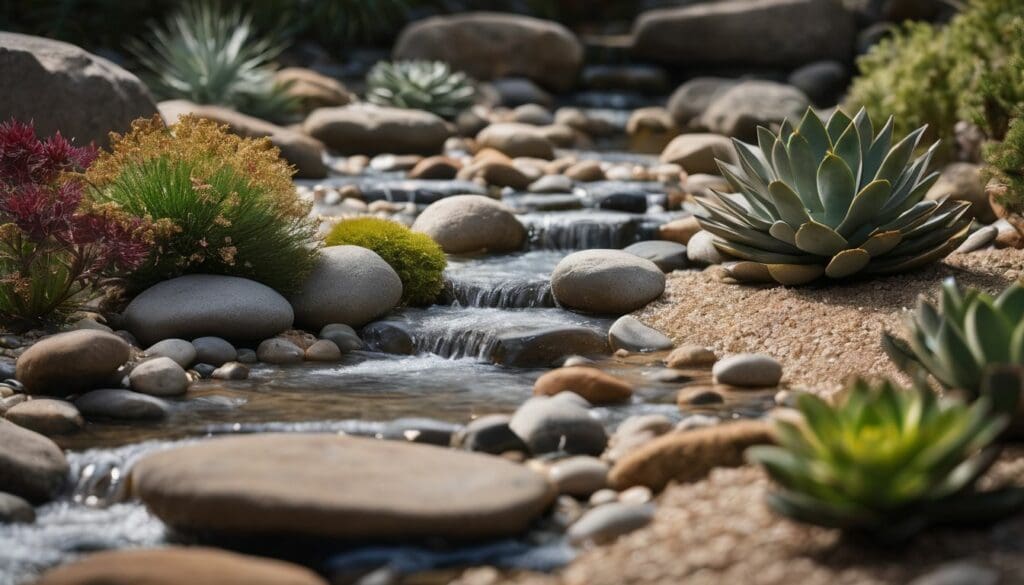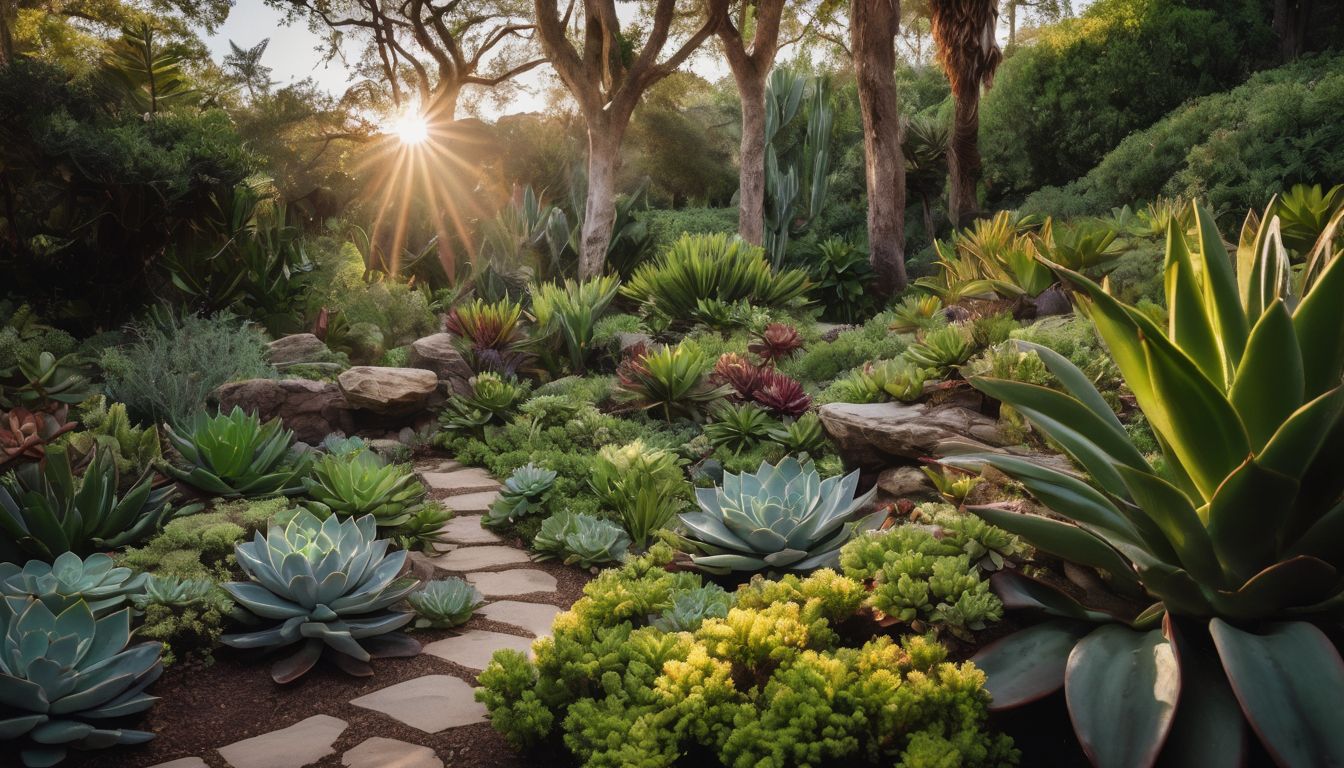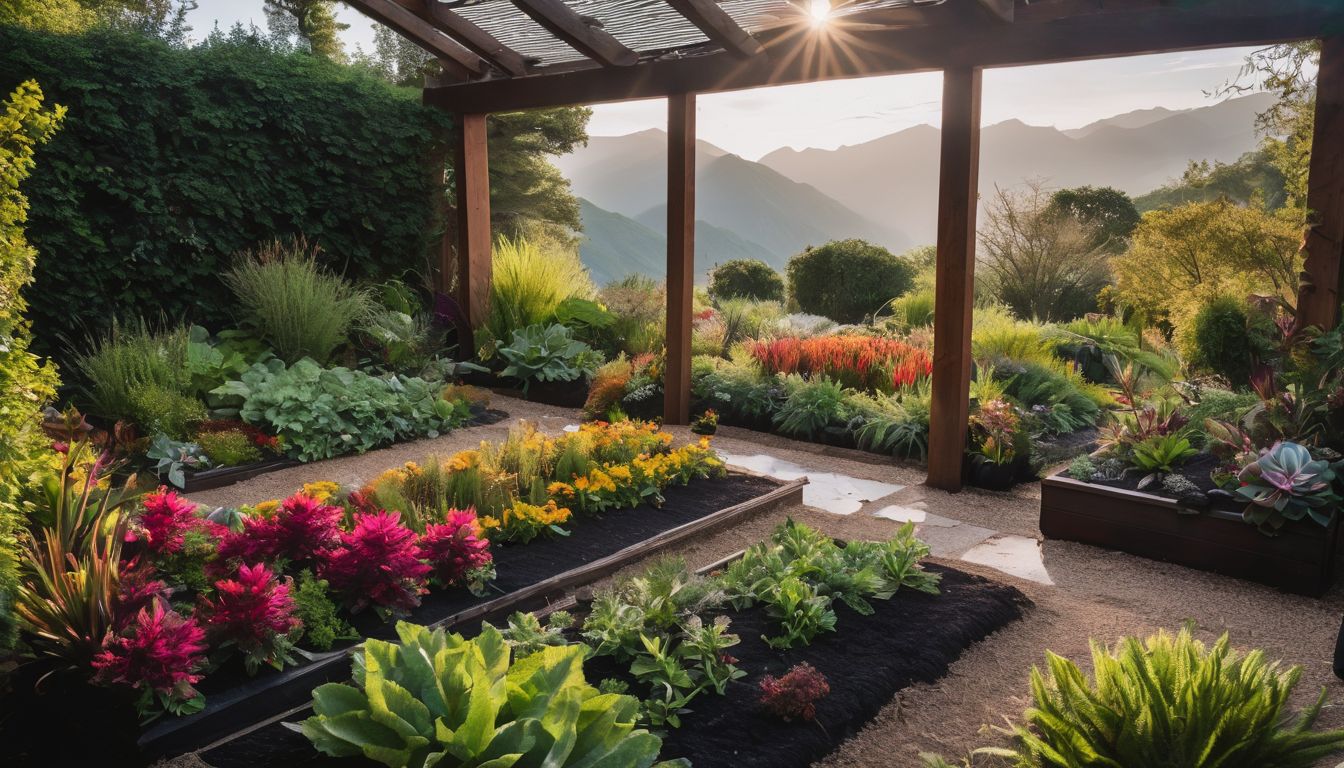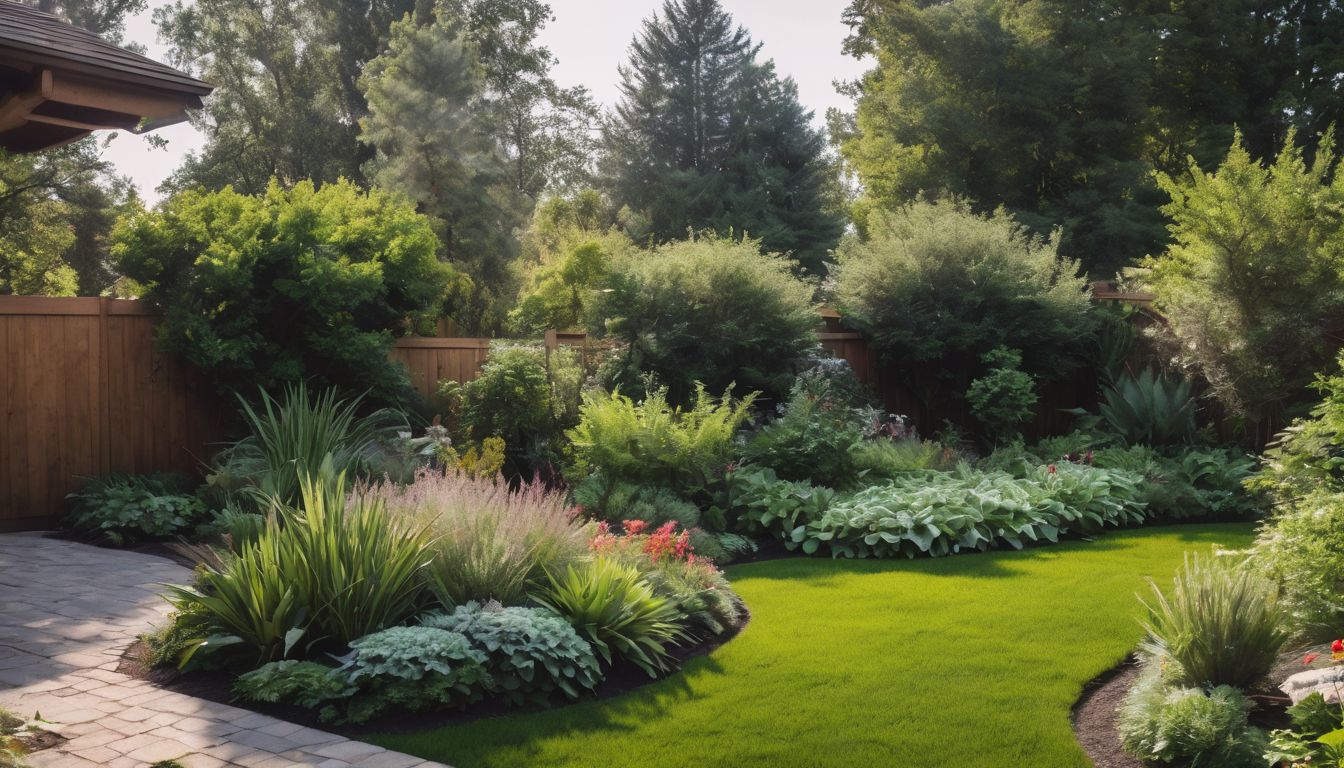Gardening can take up loads of water and effort. Rock gardens are beautiful and save precious resources. This post guides you through making your own sustainable rock haven, step by step.
Let’s dig in!
Key Takeaways
- Rock gardens save water and support local wildlife, making them an excellent choice for eco-friendly outdoor spaces.
- There are various types of rock gardens, including traditional, zen, crevice, river rock landscapes and xeric gardens; each suited to different styles and environmental conditions.
- Selecting the right location with ample sunlight and well – draining soil is vital for the success of a rock garden.
- Use native plants and drought – tolerant species in your garden design to ensure sustainability and low maintenance needs.
- Regular upkeep such as proper watering techniques, weed control without chemicals, and pruning helps maintain the health of a sustainable rock garden.
What is a Rock Garden?
A rock garden is a type of garden that incorporates rocks and stones along with carefully selected plants to create a natural and sustainable landscape. There are different types of rock gardens, each with their own set of benefits and drawbacks.
Types of rock gardens
Rock gardens add natural beauty to your outdoor space while fostering sustainability. They come in various forms, each with its own unique flair and eco-friendly benefits.
- Traditional Rock Gardens: Inspired by mountainous landscapes, these feature a mix of stones and alpine plants that require minimal water. Such gardens thrive on good drainage and often incorporate gravel mulch landscaping.
- Zen Rock Gardens: Often found in Japanese gardens, these minimalist spaces use rocks and sand to create tranquil designs. They promote contemplation and are examples of low-maintenance landscaping that harmonise with natural surroundings.
- Crevice Gardens: This type involves placing rocks closely together to form crevices where specialised plants can grow. It’s an excellent way of showcasing drought-tolerant landscaping with an exciting range of textures.
- River Rock Landscapes: Imitating the flow of water, river rock gardens use smooth stones to guide the eye through the garden. They pair well with permeable paving for sustainable water management.
- Xeric Rock Gardens: Perfect for drought-prone areas, xeric gardens focus on xeriscaping principles using native plants that require little watering. It’s a practical choice for ecofriendly garden design while conserving resources.
Benefits and drawbacks
Rock gardens are becoming increasingly popular among eco-friendly gardening enthusiasts due to their aesthetic appeal and environmental benefits. However, they also come with their own set of challenges. Here is a summary of the benefits and drawbacks:
table {
font-family: Arial, sans-serif;
border-collapse: collapse;
width: 100%;
}
td, th {
border: 1px solid #dddddd;
text-align: left;
padding: 8px;
}
th {
background-color: #f2f2f2;
}
Benefits and Drawbacks of Rock Gardens
| Benefits | Drawbacks |
|---|---|
| Low water usage aligns with conservation efforts. | Initial setup can be labor-intensive. |
| Attracts local wildlife supporting biodiversity. | Requires careful selection of suitable plants. |
| Maintenance is minimal once established. | May be challenging to achieve a natural look. |
| Provides natural drainage thus reducing erosion. | Climate conditions can limit rock garden success. |
| Materials are often locally sourced, reducing carbon footprint. | Some rock materials may be non-renewable. |
| They offer a unique aesthetic that enhances garden diversity. | Potential habitat disruption during construction. |
Enthusiasts find these gardens an excellent way to create a serene and sustainable outdoor space. With careful planning and design, the challenges can be navigated to create a beautiful, low-impact garden area.
Planning and Designing a Rock Garden
When planning and designing a rock garden, the first step is to choose the right location for your garden. Research and draw up a design that considers scale and style to create a natural look.
Choosing the right location
Selecting the perfect location for your rock garden is crucial to its success. Consider areas that receive ample sunlight and have well-draining soil, as most rock garden plants thrive in these conditions.
Ensure that the chosen area complements the natural landscape, providing a harmonious transition between your garden and surroundings. Avoid low-lying spots where water may collect, as this can lead to root rot and other issues detrimental to plant health.
When selecting a spot for your rock garden, it’s important to take into account any existing trees or shrubs nearby – their roots could compete with those of your new plants for precious nutrients and moisture.
Research and drawing up a design
Research and draw up a design for your rock garden to ensure that it fits well with the surrounding environment and creates a natural, sustainable landscape. Here are the steps to follow:
- Explore different rock garden designs that align with your vision and environmental considerations, such as using native plants and water conservation.
- Consider the scale of your rock garden in relation to its surroundings, ensuring it complements rather than overwhelms the space.
- Look into various styles that suit your outdoor area, whether it’s a minimalist gravel garden or a lush stone and plant combination.
Considering scale and style
When designing a rock garden, consider the scale and style to ensure harmony with the surrounding landscape. Scale refers to how elements in your rock garden relate to each other and the overall space.
Aim for a balanced look by varying rock sizes and heights while complementing the existing environment. Additionally, choose a design style that suits your outdoor space and personal preferences, such as naturalistic or contemporary designs, using native plants for an eco-friendly touch.
For an environmentally conscious individual, understanding scale and style is crucial in creating a sustainable rock garden that complements nature’s beauty without disturbing its balance.
Building a Rock Garden
Gathering materials from sustainable sources is key to building a rock garden. Varying the types and sizes of rocks will create a natural look and feel to your garden.
Gathering materials
To create a sustainable rock garden, gather the following materials:
- Rocks: Choose a variety of sizes and shapes to provide visual interest and natural aesthetics. Consider using local stones to reduce environmental impact.
- Soil: Opt for well-draining soil with good nutrient content to support plant growth in the rocky environment.
- Mulch or gravel: Use organic mulch or gravel made from recycled materials to conserve water and reduce maintenance needs.
- Native plants: Select drought-tolerant and indigenous plant species to promote biodiversity and support local ecosystems.
- Organic fertiliser: Use natural, slow-release fertilisers to maintain soil fertility without harming the environment.
- Watering system: Consider installing a drip irrigation system or rainwater harvesting infrastructure to minimise water usage.
Varying the rocks for a natural look
To achieve a natural look in your rock garden, use a variety of rocks in different shapes, sizes, and colours. Incorporate large boulders for focal points, medium-sized rocks for structure and texture, and small pebbles to fill in gaps.
This layering effect adds visual interest and mimics the randomness of nature.
Mix different types of rocks such as limestone, granite, or sandstone to create an authentic and diverse appearance. Ensure that your selection complements the surrounding landscape while maintaining a sustainable approach by using locally sourced materials wherever feasible.
Consider combining native plants with rock placement to enhance the natural feel of your garden. Native flora can thrive among various types of rocks creating an eco-friendly habitat for local wildlife.
Proper placement and colour choices
Varying the rocks for a natural look creates the foundation for proper placement and colour choices in your rock garden. Strategically place larger rocks as focal points, anchor smaller stones around them, and leave open spaces for planting.
Consider the colours of the rocks; darker ones absorb heat, while lighter ones reflect it. Use this to your advantage by placing dark rocks where warmth is desired, such as near plants that need extra heat retention during cooler months.
When considering colour choices, complement the hues of nearby plants with corresponding tones in your rock selection. To create visual interest and contrast, use shades from opposite ends of the colour wheel or select rocks with interesting patterns or textures.
Planting a Sustainable Rock Garden
Prepare the soil and select drought-resistant plants that complement and contrast to create a vibrant and sustainable rock garden. Learn more about creating an eco-friendly outdoor space by reading our full blog post!
Soil preparation and selection
When creating a sustainable rock garden, soil preparation and selection are essential for the success of your plants. Here are the key steps to consider:
- Test your soil for pH levels and composition to determine its suitability for your chosen plants.
- Amend the soil with organic matter such as compost or well – rotted manure to improve its structure and nutrient content.
- Select drought-resistant plants that are well-suited to the unique soil conditions in your rock garden.
- Consider native plant species, which often thrive in local soil types, reducing the need for extensive soil amendments.
- Choose plants with varying root depths to enhance soil stability and prevent erosion in your rock garden.
- Mulch the soil surface with gravel or stones to conserve moisture and regulate temperature, promoting healthy plant growth.
Choosing the right plants
Choosing the right plants is crucial for a sustainable rock garden. Consider native species that thrive in your local climate and soil conditions. Opt for drought-resistant plants to minimise water usage. When selecting plants, think about their mature size and growth habits to ensure they complement each other without overcrowding.
- Select plants that require minimal maintenance such as low – growing ground covers or ornamental grasses.
- Incorporate a variety of flowering perennials to add colour and attract pollinators.
- Introduce aromatic herbs for both culinary use and fragrance.
- Include succulents and cacti for unique textures and shapes, perfect for rock crevices.
- Choose plants with deep root systems to help stabilise the soil around the rocks.
Complementing and contrasting plant selections
When selecting plants for your rock garden, consider complementing and contrasting varieties to create visual interest. Choose plants that have different foliage textures, colours, and heights to add diversity to your garden.
Native plant species are ideal for a sustainable rock garden, as they are well-suited to the local climate and require less maintenance. Drought-resistant plants such as lavender, sedum, and yarrow are excellent choices for creating a low-maintenance and eco-friendly rock garden that also attracts pollinators.
Grouping together plants with similar water requirements will make irrigation more efficient and help maintain the overall sustainability of your rock garden. By carefully considering the combination of plant selections in terms of colour schemes and blooming seasons, you can achieve a visually appealing landscape while supporting conservation efforts through environmentally friendly gardening practices.
Maintenance for a Sustainable Rock Garden
Proper maintenance is essential for a sustainable rock garden, from regular watering and fertilisation to weed and pest control. Pruning and upkeep are also important to keep the garden looking its best.
Proper watering and fertilisation
To ensure the sustainability of your rock garden, it is important to implement proper watering and fertilisation techniques.
- Watering: Use a soaker hose or drip irrigation to deliver water directly to the plant roots, reducing water wastage.
- Rainwater Harvesting: Collect rainwater in a barrel and use it for watering the garden to minimise reliance on mains water supply.
- Mulching: Apply a layer of organic mulch around plants to retain soil moisture and suppress weed growth naturally.
- Fertilisation: Use organic fertilisers such as compost or manure to replenish nutrients in the soil without harming the environment.
- Avoid Chemicals: Refrain from using synthetic fertilisers and chemicals that can leach into the soil and harm beneficial organisms.
Weed and pest control
Weed and pest control are vital for maintaining a sustainable rock garden.
- Regularly inspect the garden for weeds and hand-pick them to prevent them from spreading. This avoids the need for chemical weed killers, promoting an eco-friendly approach.
- Introduce beneficial insects like ladybirds and lacewings to naturally control harmful pests such as aphids and mites.
- Utilise organic pest control methods such as neem oil or insecticidal soaps sparingly and in targeted areas to avoid harming beneficial insects.
- Implement companion planting with aromatic herbs like basil and lavender to deter pests while adding diversity to the garden.
- Encourage natural predators by providing habitat for birds, frogs, and lizards which help keep pest populations in check.
Pruning and upkeep
Maintaining a sustainable rock garden involves regular pruning and upkeep to ensure the health and vitality of your plants. Regularly prune dead or diseased branches, as well as any overgrown areas to encourage healthy growth while maintaining the natural aesthetic of your garden.
Keep an eye out for weeds and remove them promptly to prevent competition for resources among your chosen plants, enhancing their overall sustainability.
For optimal results, adopt a proactive approach by regularly inspecting and tending to your rock garden’s needs, promoting low-maintenance landscaping that aligns with eco-friendly principles.
By implementing these practices, you’ll sustain a flourishing rock garden that thrives in harmony with its environment.
Conclusion
In conclusion, creating a sustainable rock garden is a rewarding and eco-friendly landscaping option. By utilising native plants and natural materials, you can achieve a low-maintenance garden that supports local ecosystems.
With proper planning, designing, building, and maintenance, your rock garden can thrive in an environmentally conscious way. By following these steps, you can enjoy a beautiful outdoor space while contributing to conservation efforts.
FAQs
1. What is a sustainable rock garden?
A sustainable rock garden is an eco-friendly landscaping option featuring natural rock formations, drought-tolerant plants, and low-maintenance design elements that work in harmony with the environment.
2. How do I design a natural rock garden?
To design a natural rock garden, select stones native to your area and arrange them creatively while incorporating gravel paths or drought-resistant plants for an authentic outdoor space design.
3. Can creating a stone garden save water?
Absolutely! Using drought-tolerant landscaping techniques and choosing resilient plants minimises water use, making your stone garden both beautiful and efficient.
4. Why are native plants important in a sustainable rock garden?
Native plant garden designs support local ecosystems; they’re well-adapted to the climate, need less maintenance, and attract wildlife—vital for environmental landscaping.
5. Is it possible to have an urban sustainable rock garden?
Yes indeed! Even in urban settings, you can create low-maintenance landscapes with rocks and hardy plants that fit into smaller spaces—an excellent example of sustainable horticulture.





